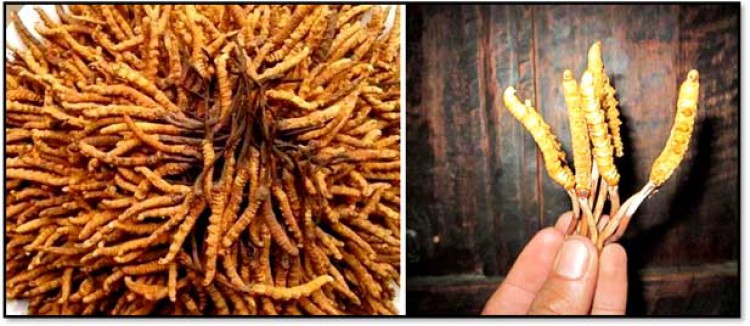




















Saturday, Nov 27, 2021 20:30 [IST]
Last Update: Saturday, Nov 27, 2021 14:49 [IST]
Yartsa gunbu is very popular in Tibetan and Chinese Traditional Medicine as a tonic and aphrodisiac since centuries and is known by the name “dbyar rtswa dgun ‘bu” or “yartsa gunbu” in Tibetan (meaning summer grass, winter worm), ‘Dong Chong Xia Cao’ in Chinese and ‘Totsi kasu’ or ‘Tochukasu’ in Japenese. It is popular by the name ‘yartsa gumba’ in the eastern Himalaya and ‘keera jhar’ in the western Himalaya and its transliteration in Dzonkha is ‘Yartsa guenboob’. It was known as “Hia Tsao Tong Tchong” and “Hea Tsaon Tsong Chung” in early English translations but now commonly called as the Chinese caterpillar fungus.
The first record of an existence of a creature, which transformed from animal to plant in summer and again from plant to animal in winter, comes from China in the year AD 620 during the reign of Tang Dynasty (AD 618 – AD 907). However, the first written records documenting the medicinal use of yartsa gunbu comes from Tibet and dates back to 15th century and mentioned by Tibetan physician Zurkhar Nyamnyi Dorjee (1439-75), who is renowned as the founder of Tibet’s Zur medicinal tradition. The Chinese came to know about its medicinal importance during the reign of Qing Dynasty and first appeared in Ben Cao Bei Yao (“Essentials of a Compendium of Materia Medica) written by Wang Ang in 1694. The western world came to know about the species in 1726 in a scientific meeting held in Paris where French Jesuit priest named Perennin Jean Baptiste du Halde narrated his experiences with the yartsa gunbu during his stay as a guest in the court of the Chinese Emperor. It was introduced in the United States by the Chinese immigrants in the mid1800s.
The legend goes as “When spring arrives and the snow starts melting in the high mountains, the indigenous people of Tibet and Nepal, as they have done for centuries, take their yak herds to grazing lands at higher elevations. Arriving in the high country, the yaks feed on the fresh spring grass. They paw the ground and remaining snow to expose and eat the Cordyceps mushroom. Then, in a frenzy, they begin rutting. As the story goes, herdsmen who observed the yaks rutting in a fever pitch wondered what gave the animals their vitality. Did they eat some kind of animal aphrodisiac? The herdsmen wondered how the animals managed to conduct themselves so vigorously in spite of the high elevation, and they wondered if what was good for the yak might be good for them. Upon close examination, the herdsmen discovered that the animals were eating an unusual mushroom, one that grew from the body of dead caterpillars. An intrepid tribesman decided to experiment for himself. He ate a Cordyceps sinensis, found the results satisfactory, and recommended it to his companions. Soon, all the tribes people were eating the mushroom. Their stamina improved and they suffered less from respiratory and other illnesses. The tribes people shared the newly discovered mushroom with monks of their acquaintance, who shared it with other monks, and soon the reputation of Cordyceps sinensis spread throughout China. Eventually, the miracle mushroom landed in the hands of the Emperor’s physicians, who prescribed it for the Emperor. Thereafter, by decree, Cordyceps could be taken only in the Emperor’s palace. All who obtained the mushroom were required by law to turn it over to officers of the Emperor” (Taken from Chapter 7 of Dr. Halpern’s book: Healing Mushroom).
In Tibet, there used to be a widespread belief amongst the nomads that yartsa gunbu is a treasure of “the earth spirits”. The digging of yartsa gunbu provokes these earth spirits who will strike the offender, his family and clan with sickness and punish his livestock with ill health; due to such belief, collection of yartsa gunbu was avoided from sacred sites / mountains. But due to the soaring market price, valued more than the gold, such belief is getting diluted, which indeed was one of the traditional ways to conserve as well as to prevent over-exploitation of yartsa gunbu.
(From SE Archives)
